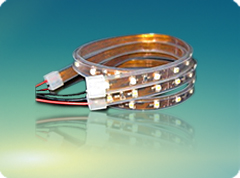The luminous principle of incandescent lamps is to heat the tungsten filament with electric energy. After long-term heating, the tungsten filament may be aging and even burned out, and the lifespan is ended. However, the luminous principle of LED lighting fixtures is determined by the special compositions of diodes, which are mainly the P-N junction, electrodes, and the optical system. When positive bias voltage is added upon electrodes, electrons and poles will be respectively injected into P- area and N- area. After minimum carriers combine with maximum carriers, surplus energy will transform into luminous energy in the form of photons. The luminous process includes three parts: injected carriers under positive bias voltage, recombination radiation, and light transmission. The continuous moving of carriers makes diodes give out lights, so diodes will not be aging or burned out. The special luminous principle of LED lighting fixtures determines that their lifespan could achieve 50,000-100,000 hours.
1. The AC-DC switching circuit installed in LED lighting fixtures should adapt to the features of LED current drive.
The power supply should not only output positive current which is almost constant current for LED lights but also have high conversion rate, thus the stable and durable working of LED lighting fixtures could be guaranteed.
2. The reliability of LED lighting fixtures
Factors that influence the reliability of LED lights are mainly LED devices and electric components. The LED light sources we adopted are from a first-class manufacturer and the main components are from European and American manufacturers.
3. The heat dissipation of LED lighting fixtures
With the development of LED chips of high power, large size, and high brightness, the heat dissipation of LED lighting fixtures and devices has to be solved. Our high power LED lights adopt heat pipe conduction, heat radiation, and natural air cooling.
4. The uniformity and optical system of LED lighting fixtures
Unlike incandescent bulbs and fluorescent lamps, the special structure of LEDs determines that they do not have problems about the uniformity, however, when LEDs combine into LED lighting fixtures (which could be seen as a “secondary light source”), the uniformity could not be guaranteed. It is a complex systematic project to make the light distribution and optical system of LED lights meet lighting demands.





